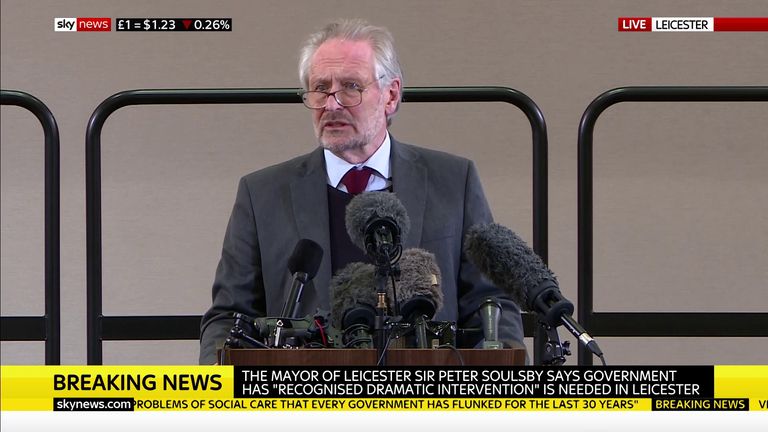Further local lockdowns are "just days away" following the drawing up of a list of 36 "at-risk" areas, Sky News understands.
Sources in Public Health England and the Department for Health told Sky News they are "working collaboratively", focusing on the 36 areas in England where coronavirus cases are rising.
As a result, local lockdowns like the one in Leicester could be implemented in "just days".
It is believed that the City of Bradford and boroughs in London, including Brent and Harrow, could be the next to lockdown after sources confirmed there were an increased number of COVID-19 cases over the last week.
There are concerns that local lockdowns may be brought on because of high numbers of Black Asian and Minority Ethnic (BAME) people in those communities.
BAME people have been disproportionately hit during the pandemic.
Some of the factors include multi-generational and overcrowded housing and the fact that many key workers are from the BAME community.
Leicester, Brent and Harrow all have high numbers of overcrowded homes, predominantly of people from a south Asian heritage.
Outside of London, Leicester has some of the highest rates of overcrowded housing in the country.
There are also a high number of ethnic minority key workers in the city.
It is estimated around a quarter of the BAME population has been working throughout this pandemic in jobs such as taxi and bus drivers, security guards and in the healthcare sector.
But there are questions over why the recommendations from the Public Health England review looking into disparities within ethnicity from COVID-19, which was given to the government at the end of May, have not been implemented.
Recommendations included targeted messages to different communities to promote COVID-19 prevention programmes and developing occupational risk assessments which take ethnicity into account.
:: Listen to the Daily podcast on Apple Podcasts, Google Podcasts, Spotify, Spreaker
Locals in Leicester believe that with these in place a local lockdown could have been prevented.
A Public Health England spokesperson said: "PHE publishes daily cases of COVID-19 broken down by local authority which includes people tested as part of pillar 1.
"This is used as one of a number of indicators to help us and partner organisations to identify trends in local areas and to take action accordingly.
"To use these data in isolation to predict which areas will see significant increases in cases is not appropriate as they do not provide a complete picture of what is happening locally."
It has been widely reported that the 36 "at-risk" areas are:
- Havering
- Wiltshire
- Wandsworth
- Gloucestershire
- Ealing
- Hammersmith and Fulham
- Doncaster
- Plymouth
- Barking and Dagenham
- Westminster
- Milton Keynes
- Wakefield
- Haringey
- Medway
- Hounslow
- Brent
- Harrow
- Kensington and Chelsea
- Slough
- Suffolk
- Redbridge
- Sandwell
- Enfield
- Tower Hamlets
- York
- Sunderland
- Wigan
- Windsor and Maidenhead
- Leicester
- Gateshead
- Isle of Wight
- Richmond upon Thames
- Portsmouth
- Redcar and Cleveland
- Derbyshire
- Walsall
Sky News is contacting all 36 local authorities, the Department of Health and the Local Government Association for comment.
Wandsworth Council leader Ravi Govindia said: "These claims of a local surge and a lockdown are wholly inaccurate and people should not panic or feel unduly alarmed."
He added: "If a scenario develops where we need to take additional steps then people can be reassured that we are well placed to do so without delay - but that is not a scenario we are facing at the moment."
Dr Mark Ansell, Havering Council's director of public health, said: "Public Health England London have reviewed cases in London and the overall trend remains downwards. We are nowhere near the levels where a lockdown would even be considered."
Dr Rupert Suckling, director of public health at Doncaster Council, said: "More data is now becoming available nationally and this will be open to scrutiny and speculation.
"Since the reporting of both pillar 1 and pillar 2 testing we have seen a high number of positive cases beginning with the week 25th to 31st May and this coincided with widespread testing in our care homes where we identified a number of asymptomatic positive cases.
"We have also seen cases in health and care workers, with sporadic cases in schools.
"However, the weekly testing from the week 8th -14th June shows a significant reduction."
https://news.google.com/__i/rss/rd/articles/CBMilQFodHRwczovL25ld3Muc2t5LmNvbS9zdG9yeS9jb3JvbmF2aXJ1cy1icmFkZm9yZC1hbmQtbG9uZG9uLWJvcm91Z2hzLWFtb25nLTM2LWF0LXJpc2stYXJlYXMtdGhhdC1jb3VsZC1iZS1qdXN0LWRheXMtYXdheS1mcm9tLWxvY2FsLWxvY2tkb3ducy0xMjAxODU5NNIBmQFodHRwczovL25ld3Muc2t5LmNvbS9zdG9yeS9hbXAvY29yb25hdmlydXMtYnJhZGZvcmQtYW5kLWxvbmRvbi1ib3JvdWdocy1hbW9uZy0zNi1hdC1yaXNrLWFyZWFzLXRoYXQtY291bGQtYmUtanVzdC1kYXlzLWF3YXktZnJvbS1sb2NhbC1sb2NrZG93bnMtMTIwMTg1OTQ?oc=5
2020-07-01 10:14:22Z
52780890396214


Tidak ada komentar:
Posting Komentar